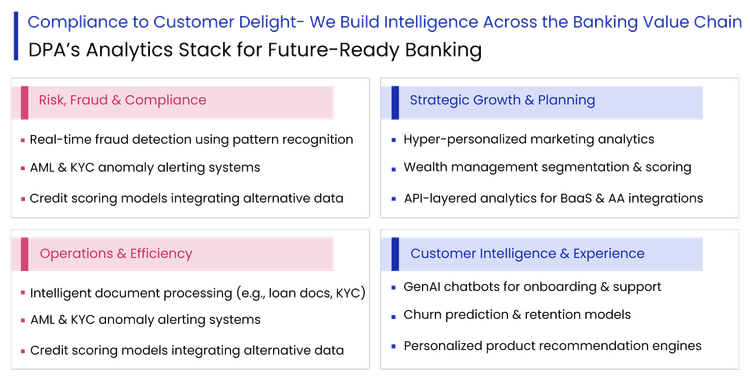
Blogs
AI in Banking: Turning Unstructured Data into Strategic Intelligence

AI in Banking: Turning Unstructured Data into Strategic Intelligence
This chaotic situation with data is becoming increasingly common in the modern banking world. A number of financial institutions today are being swamped by data originating from all kinds of sources, thanks to rapid digitalization programs. But only about 20% of this data is structured. The rest is unstructured and can be quite complex, meaning it cannot be neatly mapped to specified categories or laid out on spreadsheets or SQL databases for ready statistical analysis and business insights.
Increasingly, banks have realized they cannot afford to leave out unstructured data, idle and unused.
Now, thanks to AI and advanced analytics, it’s possible to ingest, analyze, access raw data and mine it for deep and nuanced insights.
Banks have a tremendous opportunity to tap into unstructured data by leveraging these emerging technologies and gain strategic intelligence that was impossible earlier.
Raw, unstructured data becomes valuable when it is used to inform decisions in the real-world involving actual customers.
AI models combined with ML and Natural Language Processing (NLP) powers are driving this transformation of data in numerous ways including:
AI-based analytical tools can be of great support in the bank’s marketing campaigns as well as customer service operations. These can help understand whether a customer is positively or adversely inclined or neutral in their interactions based on responses and reviews. Based on contextual information fetched by AI assistants, agents can fine-tune their interactions and recommend more relevant solutions and offerings to individual customers, thus improving outcomes and satisfaction levels.
A top Indian banking client of ours was struggling to analyze transaction patterns due to unstructured data from POS and debit records. Without accurate spend classification, they had limited customer insights and could not effectively personalize offers. As a result, their revenue growth and customer engagement suffered.
The turnaround for the bank came when they adopted an NLP-driven classification system to structure and categorize transaction data. Additionally, to address uneven expenditure distribution, they brought in nested expenditure classification models and refined algorithms for more reliable pattern identification. They could achieve precise customer spend analysis, unlocking new revenue opportunities, which allowed them to design targeted promos and retailer partnerships. The bank saw 35% more marketing effectiveness and revenue growth.
Based on these insights from such unstructured datasets, banks can re-focus and refine their innovation roadmaps to cater better to customers’ feedback and experience. They can outline new market avenues and solutions based on the gaps pointed out by the data. Such real-time insights help our clients continuously track market gaps and trends which ensures that their offerings are fresh and relevant.
A US-based leader in competitive intelligence, digital user experience research, and consulting for the financial services industry needed streamlined methods to analyze unstructured and often text-based information within commercial banks' cash offers data. To gain access to predictive intel, they aimed to move away from time-consuming methods of cleaning, processing, and analyzing massive data (about 650,000 records) held in static, unanalyzed Excel files.
The answers to these challenges came in the form of an ML-based solution to analyze cash offers by various commercials banks, infer trend and patterns, and draw deeper business insights. They also built predictive analytics capabilities around potential offers that banks were likely to make and formulate business strategy accordingly. As a result, they cut data processing time by 3 days with prompt updates to the client’s database, while drastically reducing human bias/error and ensuring focused, data-led outcomes.
There’s no denying the benefits of using AI in unstructured data mining for intelligence, and more applications will come to the fore as the technology evolves. However, many potential roadblocks must be overcome to ensure it is used effectively. Data readiness for AI models, elimination of biases, ethical practices around its use become more crucial. At the same time, technical expertise must be obtained/outsourced while keeping implementation costs under control.
Banks will benefit by finding the right AI implementation partner and consultants to ensure domain expertise as well as responsible AI and data practices. This will not only reassure end-customers that their private and sensitive data is safe but also help manage regulatory requirements as these evolve.
As a deep-tech data analytics and research firm, we have a track-record of 20+plus years in delivering value to customers across the financial services spectrum. For banks in particular, we strive to empower banks with end-to-end intelligence, starting with the data acquisition stage, to pre-processing, AI-based analysis, model creation, deployment, and all the way to advanced analytics and visualization. This is possible through our strong team of data scientists, AI engineers and functional analysts.
Be it scaling personalization, modernizing risk management, or launching BaaS, at DPA, we are experts in delivering modular analytics built for specific needs of banks.

Looking to unlock the power of unstructured data in your banking workflows? Talk to our experts today.